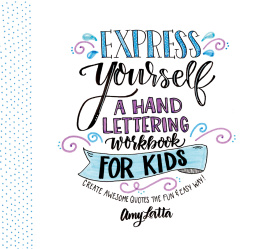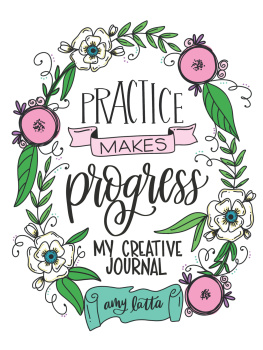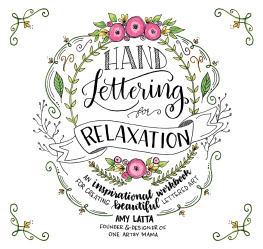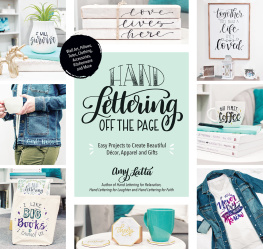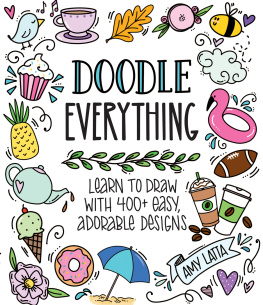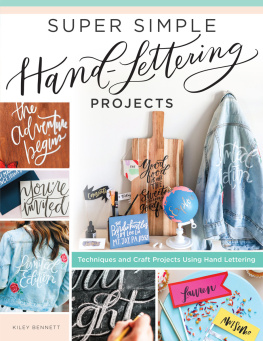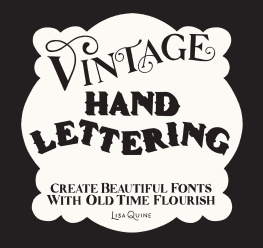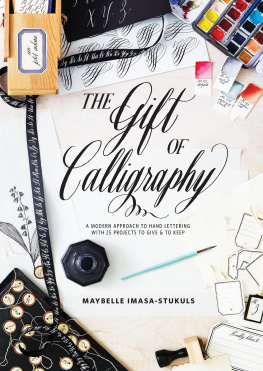Contents
Guide

The author and publisher have provided this e-book to you for your personal use only. You may not make this e-book publicly available in any way. Copyright infringement is against the law. If you believe the copy of this e-book you are reading infringes on the authors copyright, please notify the publisher at: http://us.macmillanusa.com/piracy.
FOR NATHAN AND NOAH, MY FAVORITE KIDS ON THE PLANET.
I LOVE YOU MORE.
Hi, there! Im Amy, and I think you and I have something in common. We both enjoy creating art. I love to create all kinds of crafts and DIY projects, but my absolute favorite art form is hand lettering, and I cant wait to teach you all about it. Hand lettering has gotten really popular in the last few years and, believe it or not, its something that anyone can do.
Once you learn the basics, youll want to letter everything and you can! In fact, the final chapter of this book has five simple project ideas and a long list of other ways to use your new hobby. I also have lots of lettering tutorials and practice sheets available on my blog at www.oneartsymama.com, so be sure to check those out sometime.
Now, lets get started! I cant wait to show you how to create fabulous and unique hand lettered art.

Hand lettering is a huge topic. There are more fonts, doodles and tips than anyone could possibly fit into one book. Rather than trying to learn everything at once, were going to start from the beginning and take things one step at a time. There are twenty chapters for you to go through at your own pace. Each one will teach you a new lettering style, doodle or skill that you can use to create awesome hand lettered art. Youll get step-by-step instructions as well as space to practice right here in the book. You can also have a separate sketchbook handy in case you want to continue practicing even more.
Each chapter features a sample design based on a popular quote. Well talk a little about the quote and what it means and then, at the end of the chapter, theres a special page where you can recreate that sample design using the new skills you learned. The page is blank in the center for your artwork and has a hand-drawn border around the edges that you can color in if you like. When youre finished with the book, you can always cut out your work and put it on display. You can also photograph or scan your art and share it online or print it out to frame.
Border pages can be accessed for download using the following link and password:
http://www.amylattacreations.com/express-yourself-border-pages
eyahlwfk100218
Are you ready? Lets get creative!
There are many different supplies that can be used for hand lettering. Heres a list of what youll definitely need to get started, along with some extra things you might want to pick up as you get further into the book. All of these supplies can be found online or in your favorite craft and hobby store.
FOR BASIC LETTERING
Pencil
Eraser: I use the Tombow Mono eraser
Ruler or other straightedge
Markers: I like using Tombow TwinTones for colors and Tombow Mono Drawing Pens for black, but any markers will do
Sketchbook (optional): I recommend one with medium weight paper (60 to 80 lb) that is as smooth as possible
FOR THE WATERCOLOR TECHNIQUE (CHAPTERS 620)
Water pen: I like the Pentel Arts Aquash or Martha Stewart water pens
Tombow Dual Brush Pens: these come in 96 colors and are usually sold in sets of 10
Nonabsorbent surface: I use a plastic sandwich bag or a laminated piece of cardstock
Hot-press watercolor paper (for more practice): this type of paper gives the best results because its smooth and designed not to curl when wet
FOR BRUSH LETTERING ()
Brush tip marker: I recommend the Tombow Fudenosuke or Tombow Dual Brush Pens
FOR GALAXY LETTERING ()
Supplies used for the watercolor technique (above)
White gel pen: I like the Sakura Gelly Roll
You can find a full list of all my favorite lettering and crafting supplies at www.amazon.com/shop/oneartsymama.
ONE
Do you want to know what I love most about art? Art is never wrong. Unlike a math problem that has one correct answer, art is open-ended. You can create anything you can imagine. As we work through the lessons in this book together, remember that even when something you write turns out different from what you expected, its still awesome. Your art should be your own and reflect your personality and style. Some of the lessons will be easy for you, while others might take practice and patience, but youve got this. Youre already on your way to creating amazing things!
The art of hand lettering actually includes many different styles of writing, as well as embellishments and doodles. Basically, its all about creating awesome-looking artistic designs that are focused on written words, no matter how you choose to do it. There is one particular writing style, though, thats become incredibly popular, and its the main thing most people associate with hand lettering. Its called brush script, and its basically cursive writing that has letters made with a mixture of thick and thin lines. The technique behind brush lettering is to use a special brush pen and control the thickness of the lines by the amount of pressure you put on the pen.
Later in the book, well learn and practice that technique a bit to give you a feel for how it works. Honestly, its a little tricky to do, and it will take a lot of practice and repetition before youll get the hang of it, so instead of starting with the authentic technique, were going to begin our lettering lessons with the next best thing: faux calligraphy. Faux calligraphy looks very similar to brush script, but its much easier to do! Youll be a pro at it in no time, and youll be able to write anything and everything you want in a fabulous hand lettered style. Ready to get started?
FAUX CALLIGRAPHY SCRIPT
STEP 1
Write your word in cursive.
Youll want to leave just a little bit more space in between the letters than you normally would. You can use any type of pen, marker or even a pencil to try this technique.

STEP 2
Find your downstrokes and draw a second line for each one.
Whats a downstroke? Every time you write, your pen is either moving up, down or horizontally across the page. A downstroke is any time your pen moves down toward you on the paper. The trick to getting the look we want is to draw thick downstrokes and keep all the upstrokes and horizontal strokes thin. In the example below, you can see how I have a second line only where the pen was moving down on the paper as I wrote my word.


